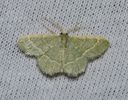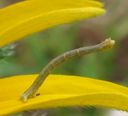Emeralds
Geometrinae
Classification
- Phylum: Arthropoda
- Subphylum: Hexapoda
- Class: Insecta
- Order: Lepidoptera
- Superfamily: Geometroidea
- Family: Geometridae
- Subfamily: Geometrinae
Pronunciation
How to pronounce Geometrinae: //ˌd͡ʒiːəˈmɛtrɪniː//
These audio files are automatically generated. While they are not always 100% accurate, they are a good starting point.
Images






Summary
Geometrinae is the nominate subfamily of the Geometridae family, known for small, often green moths characterized by their looping larval movement and variety of wing shapes and patterns. It contains many tribes, predominantly found in tropical areas, with about 2,300 described species.
Physical Characteristics
Adult small moths, often delicate green in color with some yellowish or brownish forms. Distinctive features include a plain white dorsal stripe or white spots ringed with red on the abdomen. The forewings (FW) can be pointed or rounded, and the hindwings (HW) may be angled or rounded, with varying discal spots and fringe colors (pale green, pale white, or red).
Identification Tips
Look for the distinct coloration and wing shapes, as well as specific features like the white dorsal stripe on the abdomen and the presence of smooth, wavy, or scalloped traverse lines on the wings.
Habitat
Primarily found in tropical regions, although they can inhabit diverse environments including temperate zones.
Distribution
Approximately 2,300 described species, found mostly in tropical areas.
Diet
Larvae (inchworms) typically feed on a variety of host plants, depending on the species.
Life Cycle
Involves stages from egg to larva (caterpillar), pupa (chrysalis), and adult moth.
Reproduction
Details on specific reproductive behaviors can vary widely among species within this subfamily.
Predators
Natural predators can include birds and other insectivorous animals.
Ecosystem Role
As larvae, they serve as herbivores, while adults may serve as pollinators and prey for larger predators.
Collecting Methods
- Light trapping
- Netting adults during flight
Preservation Methods
- Freezing specimens
- Pinning specimens
- Use of ethanol or other preservatives
Evolution
Strongly split into numerous tribes, confirmed by molecular phylogenetic analysis, with around 13 tribes accepted in recent classifications.
Misconceptions
Some species commonly referred to as emerald moths belong to other tribes within Geometridae.
Tags
- Geometrinae
- Emerald Moths
- Lepidoptera
- Geometridae
- Moths